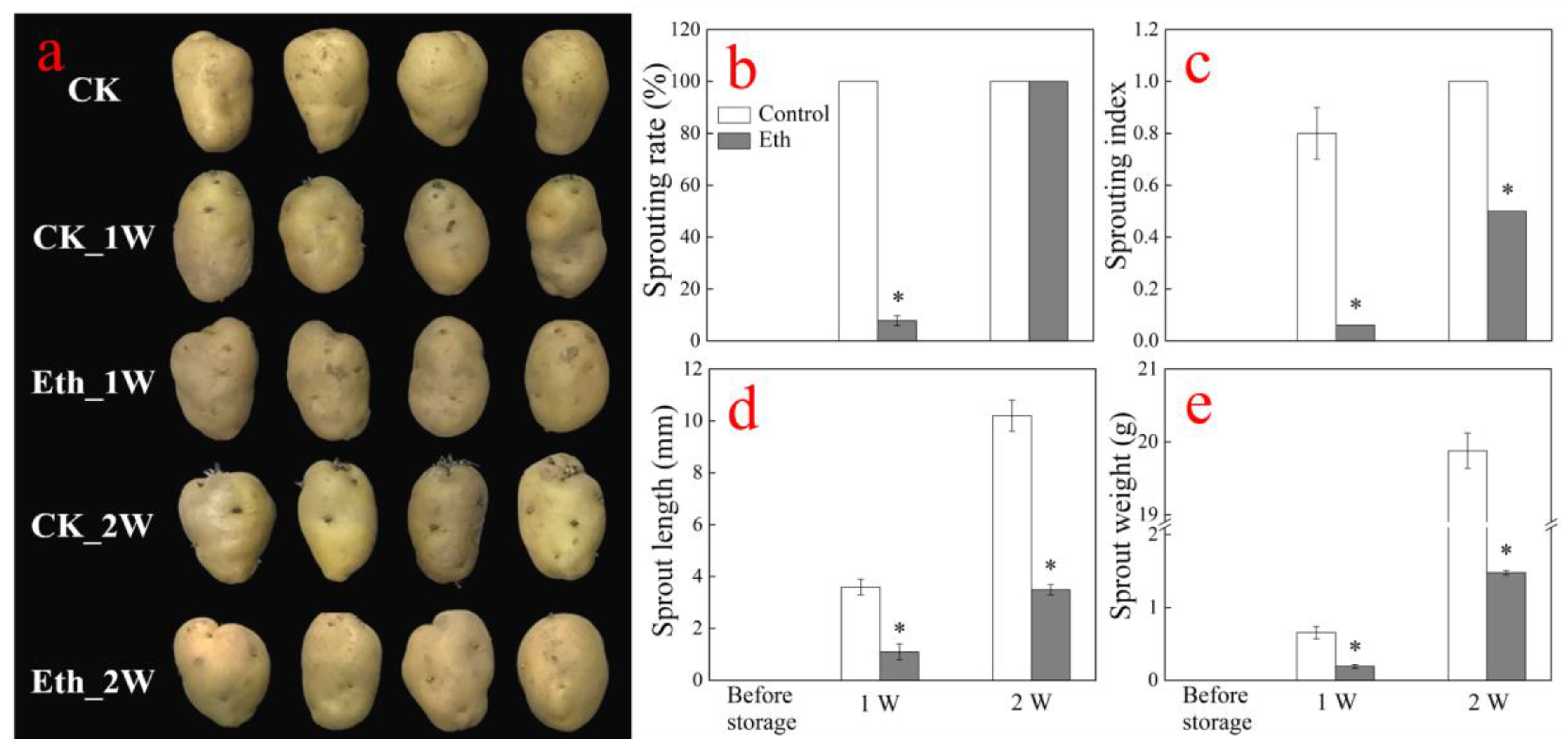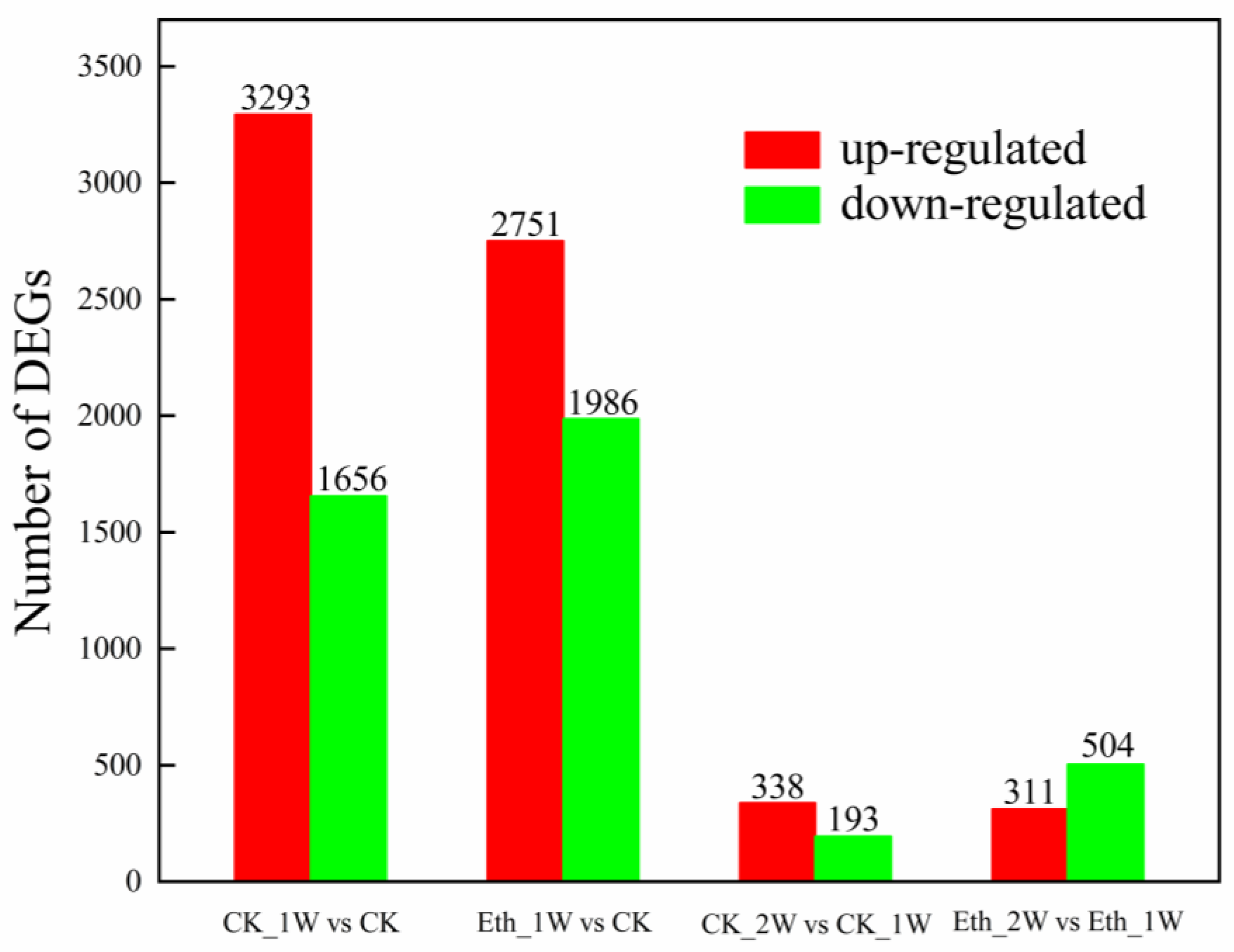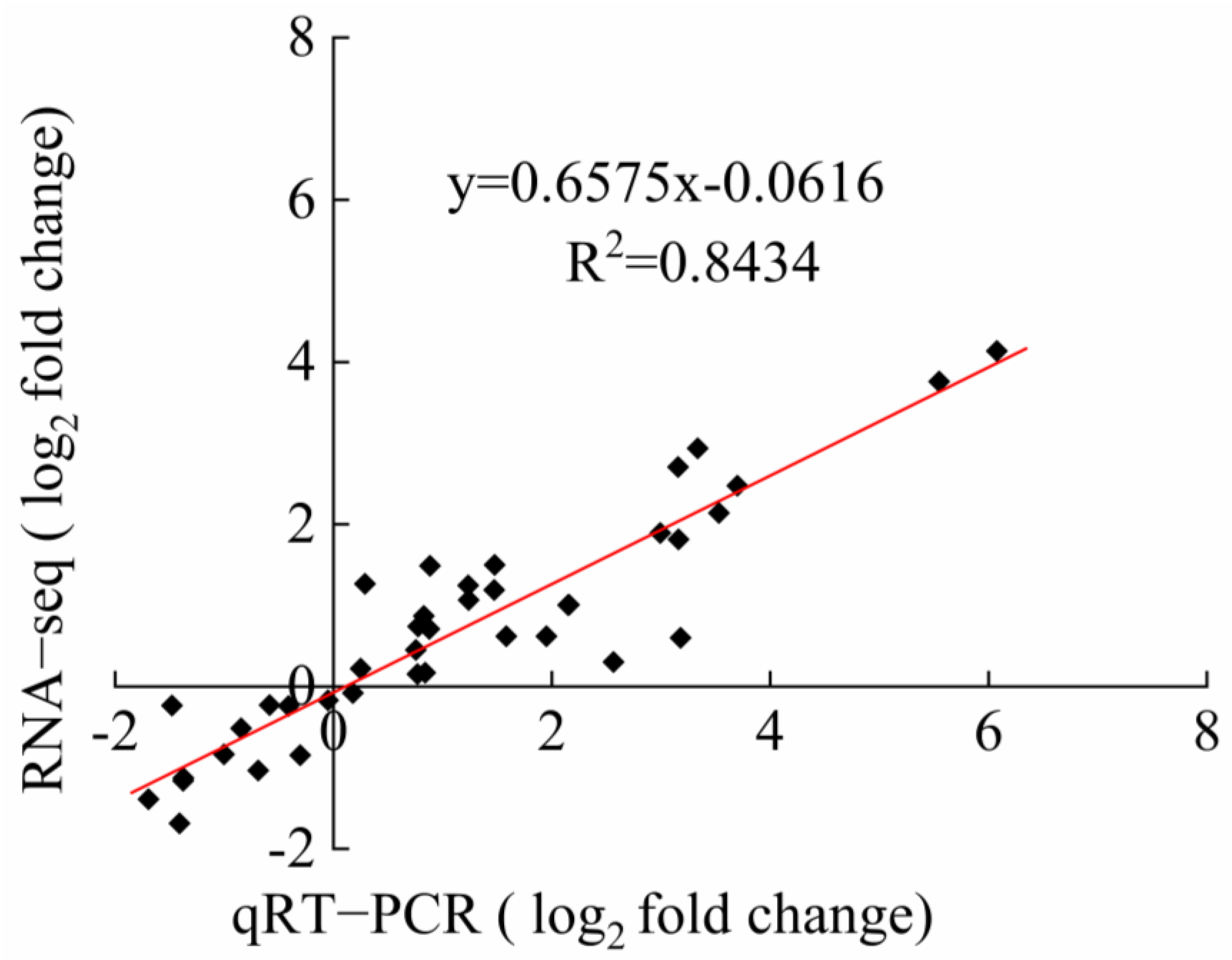Integrative Phytohormone and Transcriptome Analyses Reveal the Inhibitory Mechanism of Ethylene on Potato Tuber Sprouting at Room Temperature
Abstract
:1. Introduction
2. Materials and Methods
2.1. Plant Material and Treatment
2.2. Sprouting during Storage
2.3. Determination of Plant Hormones
2.3.1. Standard Curve
2.3.2. Metabolites Extraction
2.3.3. LC-MS Analysis
2.4. RNA Sequencing (RNA-Seq)
2.5. Quantitative Real-Time PCR (qRT-PCR)
2.6. Statistical Analysis
3. Results
3.1. Effects of Exogenous Eth Treatment on Potato Tuber Sprouting
3.2. Exogenous Eth Treatment Affects the Levels of Endogenous Hormones and Their Related Metabolites
3.3. Transcriptomic Analysis Predicted DEGs in Plant Hormone Signal Transcription in Response to Eth Treatment
3.4. Verification of DEGs by qRT-PCR Analysis
4. Discussion
5. Conclusions
Supplementary Materials
Author Contributions
Funding
Institutional Review Board Statement
Informed Consent Statement
Data Availability Statement
Conflicts of Interest
Abbreviations
References
- Ezekiel, R.; Singh, N.; Sharma, S.; Kaur, A. Beneficial phytochemicals in potato—A review. Food Res. Int. 2013, 50, 487–496. [Google Scholar] [CrossRef]
- Sonnewald, S.; Sonnewald, U. Regulation of potato tuber sprouting. Planta 2014, 239, 27–38. [Google Scholar] [CrossRef]
- Sonnewald, U. Control of potato tuber sprouting. Trends Plant Sci. 2001, 6, 333–335. [Google Scholar] [CrossRef] [PubMed]
- Sancer, O.; Şahin, U.; Ates, M.; Yünlü, S. Evaluation of genotoxic and apoptotic effects of sprouted potato. Potato Res. 2022, 65, 903–913. [Google Scholar] [CrossRef]
- Huang, Z.; Tian, S.L.; Ge, X.; Zhang, J.; Li, S.Q.; Li, M.; Cheng, J.X.; Zheng, H.W. Complexation of chlorpropham with hydroxypropyl-β-cyclodextrinand its application in potato sprout inhibition. Carbohyd. Polym. 2014, 107, 241–246. [Google Scholar] [CrossRef] [PubMed]
- Cools, K.; Alamar, M.C.; Terry, L.A. Controlling sprouting in potato tubers using ultraviolet-C irradiance. Postharvest Biol. Technol. 2014, 98, 106–114. [Google Scholar] [CrossRef]
- Gómez-Castillo, D.; Cruz, E.; Iguaz, A.; Arroqui, C.; Vírseda, P. Effects of essential oils on sprout suppression and quality of potato cultivars. Postharvest Biol. Technol. 2013, 82, 15–21. [Google Scholar] [CrossRef]
- Jia, B.; Xu, L.X.; Guan, W.Q.; Lin, Q.; Brennan, C.; Yan, R.X.; Zhao, H. Effect of citronella essential oil fumigation on sprout suppression and quality of potato tubers during storage. Food Chem. 2019, 284, 254–258. [Google Scholar] [CrossRef]
- Orawetz, T.; Malinova, I.; Orzechowski, S.; Fettke, J. Reduction of the plastidial phosphorylase in potato (Solanum tuberosum L.) reveals impact on storage starch structure during growth at low temperature. Plant Physiol. Biochem. 2016, 100, 141–149. [Google Scholar] [CrossRef] [PubMed]
- Ezekiel, R.; Singh, B. Effect of cooking and processing on CIPC residue concentrations in potatoes and processed potato products. Potato Res. 2007, 50, 175–184. [Google Scholar] [CrossRef]
- Alamar, M.C.; Tosetti, R.; Landahl, S.; Bermejo, A.; Terry, L.A. Assuring potato tuber quality during storage: A future perspective. Front. Plant Sci. 2017, 8, 2034. [Google Scholar] [CrossRef]
- Daniels-Lake, B.J.; Prange, R.K.; Kalt, W.; Walsh, J.R. Methods to minimize the effect of ethylene sprout inhibitor on potato fry colour. Potato Res. 2007, 49, 303–326. [Google Scholar] [CrossRef]
- Foukaraki, S.G.; Cools, K.; Chope, G.A.; Terry, L.A. Impact of ethylene and 1-MCP on sprouting and sugar accumulation in stored potatoes. Postharvest Biol. Technol. 2016, 114, 95–103. [Google Scholar] [CrossRef]
- Dako, E.; Jankowski, C.K.; Gnimassou, Y.M.; Lebeau, D. Study of inhibition of germination of potato by ethylene. Heliyon 2021, 7, e06175. [Google Scholar] [CrossRef]
- Suttle, J.C.; Hultstrand, J. Role of endogenous abscisic acid in potato microtuber dormancy. Plant Physiol. 1994, 105, 891–896. [Google Scholar] [CrossRef] [PubMed]
- Foukaraki, S.G.; Cools, K.; Terry, L.A. Differential effect of ethylene supplementation and inhibition on abscisic acid metabolism of potato (Solanum tuberosum L.) tubers during storage. Postharvest Biol. Technol. 2016, 112, 87–94. [Google Scholar] [CrossRef]
- Tosettia, R.; Waters, A.; Chopec, G.A.; Cools, K.; Alamar, M.C.; McWilliamc, S.; Thompsona, A.J.; Terry, L.A. New insights into the effects of ethylene on ABA catabolism, sweetening and dormancy in stored potato tubers. Postharvest Biol. Technol. 2021, 173, 11420. [Google Scholar] [CrossRef] [PubMed]
- Zhao, S.; Chen, Q.M.; Fu, M.F.; Yang, X.Y.; Qu, Q.L.; Dai, H.F. The inhibition of exogenous ethylene generated by solid ethylene-releasing agents on sprouting of potato tubers in relation to carbohydrate metabolism. Qual. Assur. Saf. Crop. 2015, 7, 423–429. [Google Scholar] [CrossRef]
- Dai, H.F.; Fu, M.F.; Yang, X.Y.; Chen, Q.M. Ethylene inhibited sprouting of potato tubers by influencing the carbohydrate metabolism pathway. J. Food Sci. Technol. 2016, 53, 3166–3174. [Google Scholar] [CrossRef] [PubMed]
- Visse-Mansiaux, M.; Tallant, M.; Brostaux, Y.; Delaplace, P.; Vanderschuren, H.; Dupuis, B. Assessment of pre-and post-harvest anti-sprouting treatments to replace CIPC for potato storage. Postharvest Biol. Technol. 2021, 178, 111540. [Google Scholar] [CrossRef]
- Le, V.N.; Nguyen, Q.T.; Nguyen, N.T.; Le, T.G.; Janda, T.; Szalai, G.; Yu-Kui, R.U.I. Simultaneous determination of plant endogenous hormones in green mustard by liquid chromatography–tandem mass spectrometry. Chin. J. Anal. Chem. 2021, 49, 111–117. [Google Scholar] [CrossRef]
- Fan, W.J.; Wang, Y.Q.; Zhang, L.; Fang, Y.J.; Yan, M.X.; Yuan, L.; Yang, J.; Wang, H.X. Sweet potato ADP-glucose pyrophosphorylase small subunit affects vegetative growth, starch content and storage root yield. Plant Physiol. Biochem. 2023, 200, 107796. [Google Scholar] [CrossRef]
- Zhen, W.N.; Tu, Y.; Lin, Z.H.; Xu, X.X.; Fu, M.R.; Han, C. Comparative transcriptome analysis reveals the molecular mechanism of UV-B irradiation in promoting the accumulation of phenolic compounds in wounded carrot. Horticulturae 2022, 8, 896. [Google Scholar] [CrossRef]
- Neubauer, J.D.; Lulai, E.C.; Thompson, A.L.; Suttle, J.C.; Bolton, M.D.; Campbell, L.G. Molecular and cytological aspects of native periderm maturation in potato tubers. J. Plant. Physiol. 2013, 170, 413–423. [Google Scholar] [CrossRef]
- Kleinkopf, G.E.; Oberg, N.A.; Olsen, N.L. Sprout inhibition in storage: Current status, new chemistries and natural compounds. Am. J. Potato Res. 2003, 80, 317–327. [Google Scholar] [CrossRef]
- Visse-Mansiaux, M.; Soyeurt, H.; Herrera, J.M.; Torche, J.M.; Vanderschuren, H.; Dupuis, B. Prediction of potato sprouting during storage. Field Crop. Res. 2022, 278, 108396. [Google Scholar] [CrossRef]
- Daniels-Lake, B.J.; Prange, R.K.; Nowak, J.; Asiedu, S.K.; Walsh, J.R. Sprout development and processing quality changes in potato tubers stored under ethylene: 1. Effects of ethylene concentration. Am. J. Potato Res. 2005, 82, 389–397. [Google Scholar] [CrossRef]
- Liu, B.L.; Zhang, N.; Wen, Y.K.; Si, H.J.; Wang, D. Identification of differentially expressed genes in potato associated with tuber dormancy release. Mol. Biol. Rep. 2012, 39, 11277–11287. [Google Scholar] [CrossRef] [PubMed]
- Suttle, J.C. Involvement of endogenous gibberellins in potato tuber dormancy and early sprout growth: A critical assessment. J. Plant Physiol. 2004, 161, 157–164. [Google Scholar] [CrossRef] [PubMed]
- Rosquete, M.R.; Barbez, E.; Kleine-Vehn, J. Cellular auxin homeostasis: Gatekeeping is housekeeping. Mol. Plant 2012, 5, 772–786. [Google Scholar] [CrossRef] [PubMed]
- Sorce, C.; Lombardi, L.; Giorgetti, L.; Parisi, B.; Ranalli, P.; Lorenzi, R. Indoleacetic acid concentration and metabolism changes during bud development in tubers of two potato (Solanum tuberosum) cultivars. J. Plant Physiol. 2009, 166, 1023–1033. [Google Scholar] [CrossRef] [PubMed]
- Muthoni, J.; Kabira, J.; Shimelis, H.; Melis, R. Regulation of potato tuber dormancy: A review. Aust. J. Crop. Sci. 2014, 8, 754–759. [Google Scholar]
- Suttle, J.C.; Huckle, L.L.; Lu, S.; Knauber, D.C. Potato tuber cytokininoxidase/dehydrogenase genes: Biochemical properties, activity, and expression during tuber dormancy progression. J. Plant. Physiol. 2014, 171, 448–457. [Google Scholar] [CrossRef] [PubMed]
- Turnbull, C.G.N.; Hanke, D.E. The control of bud dormancy in potato tubers. Planta 1985, 165, 359–365. [Google Scholar] [CrossRef] [PubMed]
- Liu, B.L.; Zhang, N.; Wen, Y.K.; Jin, X.; Yang, J.W.; Si, H.J.; Wang, D. Transcriptomic changes during tuber dormancy release process revealed by RNA sequencing in potato. J. Biotechnol. 2015, 198, 17–30. [Google Scholar] [CrossRef] [PubMed]
- Wang, H.B.; Zhang, M.L.; Song, Y.X.; Li, H.; Huang, H.; Shao, M.W.; Liu, Y.; Kang, Z.H. Carbon dots promote the growth and photosynthesis of mung bean sprouts. Carbon 2018, 136, 94–102. [Google Scholar] [CrossRef]
- Chen, Y.F.; Etheridge, N.; Schaller, G.E. Ethylene signal transduction. Ann. Bot. 2005, 95, 901–915. [Google Scholar] [CrossRef]
- Alamara, M.C.; Anastasiadia, M.; Lopez-Cobollob, R.; Bennettb, M.H.; Thompsona, A.J.; Turnbullb, C.G.N.; Mohareba, F.; Terrya, L.A. Transcriptome and phytohormone changes associated with ethylene induced onion bulb dormancy. Postharvest Biol. Technol. 2020, 168, 111267. [Google Scholar] [CrossRef]
- Nakano, T.; Suzuki, K.; Fujimura, T.; Shinshi, H. Genome-wide analysis of the ERF gene family in Arabidopsis and rice. Plant Physiol. 2006, 140, 411–432. [Google Scholar] [CrossRef] [PubMed]





| Types | Metabolites | Mass Info | Retention Time (min) | CK | CK_1W | Eth_1W | CK_2W | Eth_2W |
|---|---|---|---|---|---|---|---|---|
| Cytokinin | tZ | 220.0/136.0 | 2.031 | 16.6 ± 4.1 B | 43.4 ± 15.2 Aa | 48.2 ± 12.8 a | 45.1 ± 11.3 Ay | 75.8 ± 12.7 x |
| czR | 352.0/220.0 | 2.592 | 15.8 ± 1.3 B | 19.4 ± 3.6 ABa | 17.5 ± 1.9 a | 22.9 ± 3.9 Ax | 21.0 ± 2.6 x | |
| tzR | 352.0/220.0 | 2.608 | 1.4 ± 0.1 B | 19.9 ± 3.1 Aa | 25.5 ± 5.3 a | 20.2 ± 2.0 Ay | 50.1 ± 11.8 x | |
| iP | 204.0/136.1 | 3.872 | 0.05 ± 0.01 C | 0.17 ± 0.04 Aa | 0.14 ± 0.02 a | 0.09 ± 0.01 By | 0.18 ± 0.04 x | |
| iPR | 336.0/204.1 | 5.331 | 7.3 ± 1.2 C | 14.5 ± 1.1 Ab | 28.8 ± 4.7 a | 11.0 ± 0.2 By | 23.2 ± 4.9 x | |
| Auxin | IAA | 176.0/130.0 | 5.834 | 26.7 ± 9.0 C | 132 ± 25.5 Ba | 77.6 ± 11.6 b | 286 ± 15.9 Ax | 186 ± 72.9 y |
| Abscisic acid | ABA | 263.1/153.0 | 7.045 | 81.9 ± 4.6 B | 96.9 ± 6.1 Aa | 61.0 ± 3.2 b | 105 ± 13.3 Ax | 63.5 ± 6.3 y |
| Ethylene | ACC | 101.9/56.1 | 0.608 | 29.1 ± 2.7 B | 33.0 ± 4.1 ABa | 33.9 ± 1.1 a | 34.5 ± 3.6 Ax | 35.4 ± 1.5 x |
| Salicylic acid | SA | 137.0/93.0 | 5.474 | 27.1 ± 4.6 BC | 33.8 ± 5.3 Ba | 23.6 ± 5.8 b | 64.2 ± 13.5 Ax | 59.2 ± 28.9 x |
| Jasmonic acid | JA | 209.1/59.1 | 7.743 | nd | 0.64 ± 0.17 Ba | nd | 2.19 ± 1.14 Ax | nd |
| JA-ILe | 322.0/130.0 | 8.691 | nd | 0.02 ± 0.01 Ba | nd | 0.10 ± 0.03 Ax | nd | |
| cis-OPDA | 291.1/165.0 | 10.071 | 404 ± 44.0 B | 537 ± 65.0 Aa | 446 ± 54.5 b | 325 ± 20.8 Cy | 507 ± 97.5 x |
| Samples | Total Clean Reads | Total Mapped Reads | Unique Mapped Reads | Q30 (%) | GC Content (%) |
|---|---|---|---|---|---|
| CK_1 | 49117490 | 46554246 | 44539512 (90.68%) | 95.60 | 42.96 |
| CK_2 | 60085322 | 56922492 | 54362940 (90.48%) | 95.34 | 42.96 |
| CK_3 | 48721916 | 46245828 | 44193020 (90.7%) | 95.45 | 43.01 |
| CK_1W-1 | 54690870 | 51614444 | 47759724 (87.33%) | 95.56 | 42.48 |
| CK_1W-2 | 52915110 | 50062774 | 46359266 (87.61%) | 95.25 | 42.62 |
| CK_1W-3 | 50413250 | 47688552 | 44281584 (87.84%) | 95.39 | 42.47 |
| Eth_1W-1 | 64327208 | 60276068 | 55524598 (86.32%) | 93.36 | 42.30 |
| Eth_1W-2 | 55367714 | 51993362 | 48167102 (86.99%) | 93.23 | 42.52 |
| Eth_1W-3 | 58716980 | 55194672 | 51091124 (87.01%) | 93.09 | 42.56 |
| CK_2W-1 | 57957378 | 54643194 | 50825122 (87.69%) | 93.21 | 42.79 |
| CK_2W-2 | 49102098 | 46318434 | 43340896 (88.27%) | 93.28 | 42.74 |
| CK_2W-3 | 54091952 | 51011764 | 47733536 (88.25%) | 93.16 | 42.65 |
| Eth_2W-1 | 61568930 | 57767596 | 54604050 (88.69%) | 93.24 | 43.00 |
| Eth_2W-2 | 60278752 | 56639274 | 53698588 (89.08%) | 93.15 | 42.98 |
| Eth_2W-3 | 61998508 | 57898058 | 54490272 (87.89%) | 92.93 | 43.23 |
| KEGG Pathways | CK_1W vs. CK | Eth_1W vs. CK | Background Genes | ||
|---|---|---|---|---|---|
| Up | Down | Up | Down | ||
| Metabolic pathways | 374 | 126 | 293 | 146 | 2227 |
| Biosynthesis of secondary metabolites | 236 | 72 | 190 | 91 | 1292 |
| Photosynthesis—antenna proteins | 30 | 0 | 24 | 0 | 34 |
| Starch and sucrose metabolism | 54 | 19 | 40 | 18 | 254 |
| Photosynthesis | 31 | 0 | 21 | 2 | 87 |
| Porphyrin and chlorophyll metabolism | 18 | 3 | 14 | 4 | 48 |
| Zeatin biosynthesis | 18 | 4 | 15 | 7 | 52 |
| Plant hormone signal transduction | 60 | 19 | 44 | 19 | 326 |
| Phenylalanine metabolism | 20 | 4 | 12 | 8 | 62 |
| Phenylpropanoid biosynthesis | 56 | 4 | 37 | 8 | 245 |
| Biosynthesis of amino acids | 49 | 12 | 39 | 13 | 251 |
| Glyoxylate and dicarboxylate metabolism | 14 | 12 | 8 | 10 | 81 |
| Cyanoamino acid metabolism | 16 | 3 | 10 | 0 | 52 |
| Steroid biosynthesis | 1 | 2 | 1 | 2 | 40 |
| Butanoate metabolism | 9 | 3 | 9 | 4 | 28 |
| Carbon metabolism | 38 | 26 | 33 | 24 | 290 |
| 2-Oxocarboxylic acid metabolism | 14 | 7 | 12 | 7 | 68 |
| Cysteine and methionine metabolism | 24 | 6 | 20 | 5 | 118 |
| Glycolysis/Gluconeogenesis | 24 | 9 | 20 | 10 | 135 |
| Pentose phosphate pathway | 14 | 4 | 15 | 6 | 61 |
Disclaimer/Publisher’s Note: The statements, opinions and data contained in all publications are solely those of the individual author(s) and contributor(s) and not of MDPI and/or the editor(s). MDPI and/or the editor(s) disclaim responsibility for any injury to people or property resulting from any ideas, methods, instructions or products referred to in the content. |
© 2024 by the authors. Licensee MDPI, Basel, Switzerland. This article is an open access article distributed under the terms and conditions of the Creative Commons Attribution (CC BY) license (https://creativecommons.org/licenses/by/4.0/).
Share and Cite
Zhang, M.; Jiao, W.; Chen, Q.; Fu, M.; Han, C. Integrative Phytohormone and Transcriptome Analyses Reveal the Inhibitory Mechanism of Ethylene on Potato Tuber Sprouting at Room Temperature. Horticulturae 2024, 10, 286. https://doi.org/10.3390/horticulturae10030286
Zhang M, Jiao W, Chen Q, Fu M, Han C. Integrative Phytohormone and Transcriptome Analyses Reveal the Inhibitory Mechanism of Ethylene on Potato Tuber Sprouting at Room Temperature. Horticulturae. 2024; 10(3):286. https://doi.org/10.3390/horticulturae10030286
Chicago/Turabian StyleZhang, Meixue, Wenxiao Jiao, Qingmin Chen, Maorun Fu, and Cong Han. 2024. "Integrative Phytohormone and Transcriptome Analyses Reveal the Inhibitory Mechanism of Ethylene on Potato Tuber Sprouting at Room Temperature" Horticulturae 10, no. 3: 286. https://doi.org/10.3390/horticulturae10030286





